英语论文提纲范文
英文论文提纲的格式范文_论文格式_
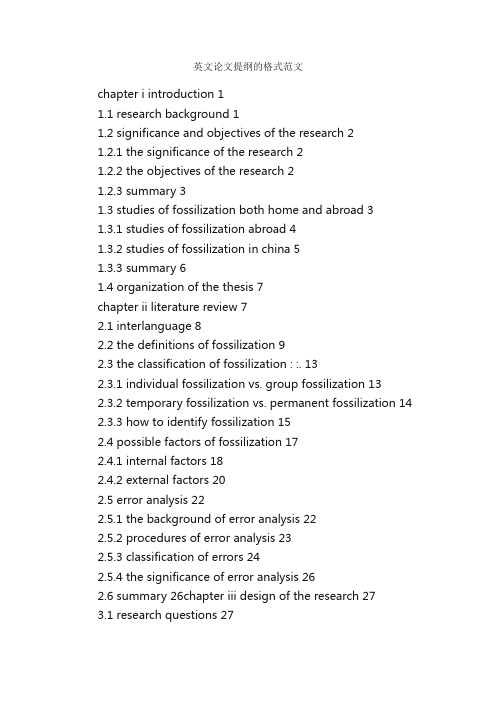
英文论文提纲的格式范文chapter i introduction 11.1 research background 11.2 significance and objectives of the research 21.2.1 the significance of the research 21.2.2 the objectives of the research 21.2.3 summary 31.3 studies of fossilization both home and abroad 31.3.1 studies of fossilization abroad 41.3.2 studies of fossilization in china 51.3.3 summary 61.4 organization of the thesis 7chapter ii literature review 72.1 interlanguage 82.2 the definitions of fossilization 92.3 the classification of fossilization : :. 132.3.1 individual fossilization vs. group fossilization 132.3.2 temporary fossilization vs. permanent fossilization 14 2.3.3 how to identify fossilization 152.4 possible factors of fossilization 172.4.1 internal factors 182.4.2 external factors 202.5 error analysis 222.5.1 the background of error analysis 222.5.2 procedures of error analysis 232.5.3 classification of errors 242.5.4 the significance of error analysis 262.6 summary 26chapter iii design of the research 273.1 research questions 273.2 subjects 283.3 method 283.4 instruments 293.5 procedures 293.6 summary 30chapter iv result and discussion 314.1 data analysis 314.1.1 classification of errors 314.1.2 analysis of the errors 314.2 the design of the questionnaires 374.3 the analysis of the questionnaires 384.4 analysis of causes of fossilized errors in writing 40 4.5 summary 42chapter v strategies for fossilization avoidance 435.1 to take a good attitude to the interference of li 43 5.2 to enhance the learners' motivationr445.3 to guarantee the quality and quantity of l2 input 46 5.4 to provide effective feedback 485.5 to attach more importance to grammar teaching 49 5.6 to apply more effective learning strategies 495.7 summary 50chapter vi conclusion 516.1 a brief review of the study 516.2 major findings 526.3 limitations of this study 536.4 suggestions 54bibliography 55。
英语作文提纲范例大全

英语作文提纲范例大全Title: The Importance of Education。
Introduction。
Definition of education。
Importance of education in personal and societal development。
Body。
1. Personal development。
Education provides knowledge and skills。
Increases opportunities for personal growth and success。
2. Societal development。
Educated individuals contribute to the development of society。
Education promotes social equality and justice。
3. Economic development。
Education leads to higher earning potential。
Educated workforce drives economic growth。
4. Global development。
Education fosters global citizenship。
Educated individuals can contribute to global issues。
Conclusion。
Recap of the importance of education。
Call to action for promoting education for all。
Essay:Education is the process of acquiring knowledge, skills, values, and attitudes that enable individuals to contribute to their personal development and the development of society. It is an essential tool for personal growth, societal progress, economic development, and global citizenship. The importance of education cannot be overstated, as it plays a crucial role in shaping thefuture of individuals and the world at large.First and foremost, education is vital for personal development. Through education, individuals gain knowledge and skills that are necessary for success in their personal and professional lives. Education provides the foundationfor critical thinking, problem-solving, and decision-making, which are essential for navigating the complexities of the modern world. Furthermore, education opens up opportunities for personal growth and self-improvement, allowing individuals to reach their full potential and achieve their goals.In addition to personal development, education is also essential for societal progress. Educated individuals are more likely to contribute to the development of their communities and societies. They are better equipped to understand and address social issues, and are more likelyto engage in activities that promote the common good. Furthermore, education promotes social equality and justice by providing individuals with the tools to advocate fortheir rights and the rights of others.Moreover, education is crucial for economic development.A well-educated workforce is essential for driving economic growth and prosperity. Educated individuals are more likely to secure stable and well-paying jobs, which in turn leadsto higher standards of living and improved quality of life for communities. Additionally, education fosters innovation and entrepreneurship, which are essential for the development of a dynamic and thriving economy.Furthermore, education is important for global development. In an increasingly interconnected world,education is essential for fostering global citizenship and understanding. Educated individuals are better equipped to engage with people from diverse backgrounds and cultures, and are more likely to contribute to global issues such as poverty, inequality, and environmental sustainability.In conclusion, education is of paramount importance for personal, societal, economic, and global development. It is a fundamental human right and a key driver of progress and prosperity. It is essential that all individuals have access to quality education, regardless of their background or circumstances. By promoting education for all, we can create a more just, equitable, and sustainable world for future generations.。
英文作文提纲示范
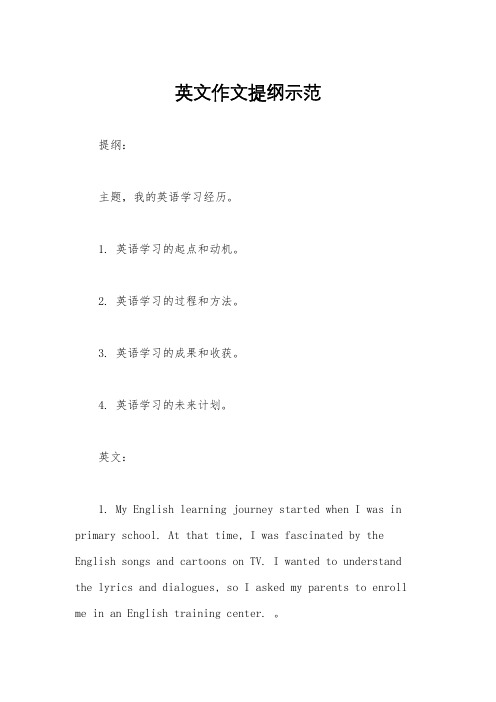
英文作文提纲示范提纲:主题,我的英语学习经历。
1. 英语学习的起点和动机。
2. 英语学习的过程和方法。
3. 英语学习的成果和收获。
4. 英语学习的未来计划。
英文:1. My English learning journey started when I was in primary school. At that time, I was fascinated by the English songs and cartoons on TV. I wanted to understand the lyrics and dialogues, so I asked my parents to enroll me in an English training center. 。
中文,我的英语学习之旅始于我上小学的时候。
那时候,我对电视上的英文歌曲和卡通片很着迷,想要理解歌词和对话,于是我请求父母让我去报名参加英语培训班。
2. In the beginning, I learned English mainly through memorizing vocabulary and grammar rules. However, I foundit hard to apply what I've learned in real-life situations. Later on, I realized that the key to mastering a languageis to practice speaking and listening. Therefore, I started to watch English movies and TV shows, listen to English podcasts, and speak with my foreign friends. 。
中文,一开始,我主要通过背单词和语法规则来学习英语。
提纲式作文示范英语

提纲式作文示范英语Title: The Power of Education in Shaping Society。
Introduction:Education plays a pivotal role in shaping societies, influencing individuals, and driving progress. Its impact spans across generations, economies, and cultures. In this essay, we delve into the multifaceted influence of education on society, exploring its significance, challenges, and potential solutions.I. Education and Economic Development:1. Education fosters economic growth by equipping individuals with skills and knowledge essential for modern industries.2. Educated populations are more likely to innovate, adapt to technological advancements, and contribute to anation's competitiveness in the global market.3. Access to quality education reduces incomeinequality and enhances social mobility, laying the foundation for a more inclusive society.II. Education and Social Cohesion:1. Education promotes social cohesion by fostering understanding, empathy, and respect for diversity.2. Schools serve as melting pots where individuals from various backgrounds come together, fostering tolerance and cooperation.3. Education instills values of citizenship, democracy, and human rights, nurturing responsible and engaged citizens.III. Education and Public Health:1. Education is a key determinant of health outcomes,influencing behaviors related to nutrition, hygiene, and disease prevention.2. Educated individuals are more likely to access healthcare services, leading to improved overall health outcomes and reduced healthcare costs.3. Investing in education, particularly in health education, yields long-term benefits by promoting healthier lifestyles and reducing the burden of disease.IV. Challenges in Education:1. Access to quality education remains a challenge in many parts of the world, particularly in marginalized communities and developing countries.2. Disparities in educational attainment persist, perpetuating social inequalities and hindering progress towards sustainable development goals.3. Educational systems often face funding constraints,teacher shortages, and outdated curricula, compromising the quality of education provided.V. Solutions and Recommendations:1. Prioritize investment in education, allocating resources to ensure universal access to quality education for all.2. Enhance teacher training and support to improve the quality of instruction and promote student engagement.3. Embrace innovative approaches to education, leveraging technology and alternative learning modalities to reach underserved populations.4. Foster partnerships between governments, civil society, and the private sector to address systemic challenges and promote educational equity.Conclusion:Education serves as a catalyst for social change, economic development, and individual empowerment. By investing in education and addressing systemic barriers, societies can unlock human potential, foster inclusive growth, and build a more prosperous and equitable future for all.。
英语论文提纲范例大全13篇
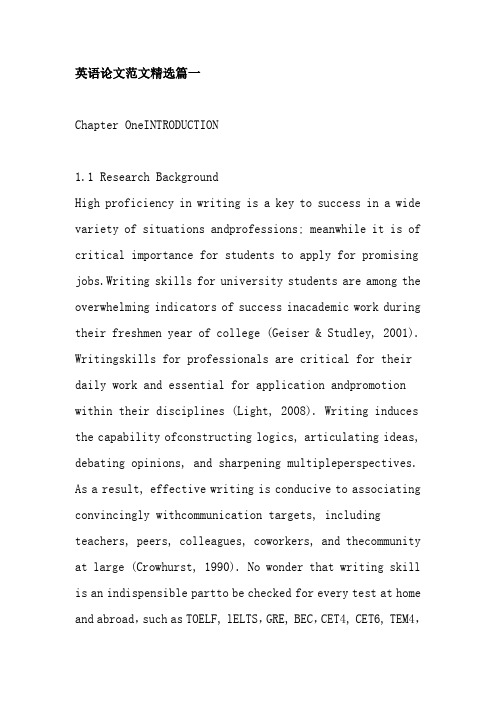
英语论文范文精选篇一Chapter OneINTRODUCTION1.1 Research BackgroundHigh proficiency in writing is a key to success in a wide variety of situations andprofessions; meanwhile it is of critical importance for students to apply for promising jobs.Writing skills for university students are among the overwhelming indicators of success inacademic work during their freshmen year of college (Geiser & Studley, 2001). Writingskills for professionals are critical for their daily work and essential for application andpromotion within their disciplines (Light, 2008). Writing induces the capability ofconstructing logics, articulating ideas, debating opinions, and sharpening multipleperspectives. As a result, effective writing is conducive to associating convincingly withcommunication targets, including teachers, peers, colleagues, coworkers, and thecommunity at large (Crowhurst, 1990). No wonder that writing skill is an indispensible partto be checked for every test at home and abroad,such as TOELF, lELTS,GRE, BEC,CET4, CET6, TEM4,TEM8 and so on.Notwithstanding such manifestation of the significance of writing, it is reported in the2002 National Assessment of Educational Progress (NAEP) report in the U.S.A. that lessthan a third of students in Grade 4 (28%),Grade 8 (31%), and Grade 12 (21%) scored at orabove proficient levels,and only 2% wrote at advanced levels for all three samples.Moreover, only 9% of Grade 12 Black students and only 28% of Grade 12 White studentswere able to write at a proficient level (National Center for Educational Statistics, 2003).……………1.2 Significance of the ResearchBased on the CET 4 and CET6 compositions extracted from the CLEC,the study aimsto reveal the relationship between the linguistic features and the writing quality by meansof the advanced software,namely Lexical Frequency Profile, Coh-Metrix3.0 and L2Syntactic Complexity Analyzer for the analysis of vocabulary, syntax and textual cohesion.This study will be of great value mainly for the following two aspects:Firstly, theoretically speaking, the study is going to offer guidance and reference forthe teachingmethodology of L2 writing. The study reveals the contribution of lexicaldiversity, syntactic complexity, textual cohesion to writing quality, reflects the mostdecisive factor of the writing quality and analyzes the mutual relationship between thelexical diversity and quality of writing, the syntactic complexity and quality of writing aswell as the textual cohesion and quality of writing. Hopefully, this research will shedsome light on the instruction of CET 4 and 6 writing and provide practical advice.Secondly, practically speaking, the study demonstrates a new direction for thedevelopment of automatic assessment of the writing. The study is to be carried out bothby means of software and labor work to comprehensively examine more than 28variables that might have an impact on writing quality and build the relation modelbetween these related variables and writing scores. ……………Chapter TwoLITERATURE REVIEW2.1 Lexical Features and Quality of WritingIn the process of L2 writing,students are always perplexed by vocabulary. Leki&Carson (1994) surveyed 128 L2 learners to know about their feelings on the courseEnglish for Academic Purposes (EAP). It is discovered that the strongest zeal for studentsis to improve their language proficiency, especially lexical proficiency. Jordan (1997)obtained the similar conclusion in his study on Chinese students in UK applying for theirmaster degrees, 62% of whom regarded vocabulary as their biggest problem in the processof English writing. Over the past two decades,researchers have attached more and more importance toL2vocabulary studies. As an important element of language proficiency, lexical proficiency isdefined from different perspectives and evaluated by a series of measurements. Meanwhile, lexical proficiency, to a large extent, is embodied by lexical features. As a matter of fact,studies on lexical features have received more and more attention from home and abroadresearchers mainly focusing on total words, lexical diversity (LD) or lexical richness (LR)and lexical complexity (LC), among which lexical diversity or lexical richness has gainedmore popularity for lexical proficiency study.……………2.2 Syntactic Features and Quality of WritingSyntactic complexity (also called syntactic maturity,or linguistic complexity),isimportant in the prediction of the quality of student writings. Wolfe-Quintero et al. (1998)pointed out that a syntactically complex writer uses a wide variety of both basic andsophisticated structures,while a syntactically simple writer uses only a narrow range ofbasic structures. In the past half century, researchers adopted many different indices tostudy the syntactic complexity and attempted to find out the relationship among the scores,the grades, the ages and the writing quality. Syntactic complexity is defined as “the range of forms that surface in languageproduction and the degree of sophistication of such forms” (Ortega, 2003). It is animportant factor in the second language assessment construct as described in Bachman's(1990) conceptual model of language ability, and therefore is often used as an index oflanguage proficiency and development status of L2 learners. Various studies have proposedand investigated measures of syntactic complexity as well as examined itspredictivenessfor language proficiency, in both L2 writing and speaking settings, which will be reviewedrespectively.Syntactic complexity is also called syntactic maturity, referring to the range oflanguage production form and the degree of the form complexity. Therefore,the length ofthe production unit, the amount of the sentence embeddedness and the range of thestructure type are all the subjects of the syntactic complexity (Ortega 2003: 492).………CHAPTER THREE METHODOLOGY (20)3.1 Composition Collection (20)3.2 Tools (21)3.3 Variables (23)3.3.1 Dependent variables (25)3.3.2 Independent variables (26)3.4 Data Analysis (28)CHAPTER FOUR DATA ANALYSIS AND RESULTS (30)4.1 Quantitative Differences in High- and Low- Proficiency Writings-1ivviv (30)4.2 Comparison between Quantitative Features of CET4 (38)4.3 Impacts of Quantitative Features on Writing Quality (47)5.1 Lexical Diversity and Writing Quality (47)5.2 Syntactic Complexity and Writing Quality (48)5.3 Textual Cohesion and Writing Quality (49)Chapter FiveDICUSSION5.1 Lexical Diversity and Writing QualityU index assessing lexical diversity has showed significant difference between high-and low-proficiency writing both in CET4 and CET6. It may suggest thathigh-proficiencywritings have displayed more diverse vocabularies, which is different from the study ofWang (2004). In his study, the target students have a similar lexical diversity. Among theindices assessing lexical study in his study, none index has showed significant differencebetween high- and low-proficiency writings or correlated with writings scores. In his study,he explained the possible reason for such a result that there issignificant difference inaverage words. However, this result is probably attributed to his measurement of lexicaldiversity. In his study, TTR was employed as an index of lexical diversity, but asmentioned above, TTR is reliable only when texts have the same length. In Wang's study,texts vary in length; thus longer texts tend to have lower TTR. That is why the relationshipbetween lexical diversity and writing quality is blurred. But in this study, we adopted Uindex to measure lexical diversity in CET compositions, for U index can avoid theweakness of TTR and eliminate the influence of text length. Besides, Liu (2003) studied 57second- year college students in two natural classes and found out that vocabulary size hadno immediate effect on writing score. However, the result that lexical diversity has apositive impact on the quality of writing in this study is in accordance with the study ofMcNamara et al. (2001).……………ConclusionThis study aims to explore the relationship between lexical features and L2 writingquality with the help of Lexical Frequency Profile, the relationship between syntacticfeatures and L2 writing quality through the use of the computational tool L2 SyntacticComplexity Analyzer and the relationship between cohesive features and second languagewriting quality with the help of the computational tool Coh-Metrix3.0. Meanwhile, thestudy gives us information about the textual representation of different writingproficiencies along multiple textual measurements.This section summarizes the major findings of this study and presents theoretical,methodological and pedagogical implications for L2 writing research. Limitation of thepresent study and suggestions for further studies are raised in the end.……………Reference (omitted)英语论文范文精选篇二Chapter One Introduction1.1 Background of the ResearchEnglish writing is an important way of communication, which can enhance the ability oflanguage acquisition in the process of second language learning. As one of the language skills,English writing is very difficult to master. After many years, students still find that their writingis unsatisfactory and have many problems. It is widely acknowledged that much attentionshould be paid to English writing. At present our college English writing teaching is time-consuming and low effectiveness, for teachers spend a lot of time and energy reading andcorrecting students’ compositions, but the efficiency is not high; at the same time, studentsspend a lot of time writing, and the results are not satisfactory.The following conspicuous problems tend to exist in the English writing. First, when givena topic, students tend to think in Chinese and do a translation job. Second, students spend toomuch time avoiding grammatical errors in the process of writing, which leads to the ignoranceof the organization of the compositions in a comprehensive view. Third, enriching the contentduring the writing process is difficult for students, for they fail to support their viewpointswithappropriate examples and strong arguments. English writing is the weakest part in Englishlearning especially for Chinese Vocational college students. According to Basic Teaching Requirements for Vocational College English Course,developing students’ comprehensi ve abilities to use English language is the teaching aim ofvocational college English. In terms of writing, students should have the ability to master thebasic writing skills and accomplishing writing tasks of different types, including narration,description, argumentation and practical writings like business email or announcement.Besides,their writing should have a clear organization and proper coherence; at the same time, studentsshould be able to write or describe something with adequate content and proper form indifferent situations, such as business situation.…………1.2 Purpose and Significance of the ResearchAs we can see, most English class in the vocational colleges is always a big class which contains at least sixty students and in the class students may not receive the feedbackfromteacher immediately, although offering feedback is one of the essential tasks. It is helpful andefficient for teachers that students themselves can check other s’ writing and give comments. Sothese two feedbacks have their own roles in the revision. Considering the vocational collegeeducation, examining the practice of teacher feedback and peer feedback on EFL writing is ofgreat importance and necessity. This study is aimed to discuss the effects of teacher feedbackand peer feedback in the English class in order to provide some useful English writing teachingmethod and studying ways for vocational college education. This is not only consistent with thespirit of the new curriculum; at the same time reflects the “student-c entered” teachingphilosophy.…………Chapter Two Literature Review2.1 Feedback TheoryFeedback is widely seen in education as crucial for both encouraging and consolidatinglearning (Anderson, 1982; Brophy, 1981; Vygotsky, 1978), and the importance has alsobeenacknowledged in the field of English writing.In language learning, feedback means evaluative remarks which are available to languagelearners concerning their language proficiency or linguistic performance(Larsen-Freeman,2005). In the filed of teaching and learning, feedback is defined as many terms, such asresponse, review, correction, evaluation or comment. No matter what the term is, it can bedefined as “comments or information learners receive on the success of a learning task, eitherfrom the teacher or from other learners (Richards et al., 1998)”.A more detailed description of feedback in terms of writing is that the feedback is “inputfrom a reader to a writer with the effect of providing information to the writer for revision”(Keh, 1990). From the presentation of general grammatical explanation to the specific errorcorrection is all the range of feedback. The purpose is to improve the writing ability of studentsby the description and correction of the errors.The role of feedback is to make writers learn where he or she has misled or confused thereader by supplying insufficient information, illogical organization, lack ofdevelopment ofideas, or something like inappropriate word-choice or tense (Keh, 1990).…………2.2 Theoretical Foundations of FeedbackCollaborative learning, also called cooperative learning, is the second theoretical basis thatback for the application of feedback in writing class. It is feasible that students communicateactively with each other in the classroom.There is a clear difference betweenstudents-centered and traditional teacher-ledclassrooms. Students’ enthusiasm of participating in group discussion strengthens whenstudents are completely absorbed in collaborative learning in the students-centered class. Whenstudents get together to work out a problem, ideas are conveyed among them and immediatefeedback is received from their group members.Collaborative learning emphasizes that both students and instructors participate and interact actively (Hiltz, 1997). Collaborative learning is viewed from both behavioral andhumanistic perspectives (Slavin 1987). The behavioral perspective stresses that students areencouraged to study under a cooperativesituation and rewarded in the form of group rather thanindividual ones. As for the humanistic perspective, more understanding and better performanceare gained from the interaction among peers. So it is obvious that collaborative learning putsmore attention to the influence of peers, which is different from the previous English writingteaching theories(Johnson and Johnson,1986).Collaborative learning make the students work and learn together to maximize their ownand other’s study.…………Chapter Three Research Methodology (21)3.1 Research Questions (21)3.2 Subjects (21)3.3 Instruments (22)3.3.1 Writing Tasks (23)3.3.2 Questionnaires (23)3.3.3 Pre-test and Post-test (24)3.4 Research Design (24)3.5 Data Collection (27)Chapter Four Results Presentation and Discussion (29)4.1 Students’ Changed Writing P roficiency (29)4.2 Students’ Changed Interest in English Learning and Writing (36)Chapter Five Conclusion (43)5.1 Major Findings (43)5.2 Pedagogical Implications and Suggestions (44)5.3 Limitations of the Study (46)5.4 Suggestions for Further Study (46)Chapter Four Results Presentation and Discussion4.1 Students’ Changed Writing ProficiencyThe data from the pre-test and post-test of the EC and CC were all collected and analyzedthrough SPSS 13.0 to investigate the difference before and after the adoption of teacherfeedback and peer feedback in the English writing class. As table4-1 shows, the mean score of the control class (11.43) is rather similar to theexperimental class (11.56). Moreover, the standard deviation of experimental class (9.357) isalso rather similar to that of the control class (9.421). The mean score of the experimental groupisa little bit higher than that of control the group(11.56>11.43), but the disparity is only 0.13,and thelowest score and the highest score of the two groups are quite close to each other.On the basis of the group statistics of the pre-test, the author carried out an independentsamples t-test in order to further compare the mean scores of the pre-test between CC and EC.Table 4-2 shows the Sig is 0.624, higher than 0.05, showing the writing proficiency of twogroups have no significant difference. Thereby, the statistics in the row of “Equal variancesassumed” should be observed. The Mean Difference is merely 0.338, and the Standard ErrorDifference is only 2.086. In addition, Sig. (2-tailed) is 0.836 (>.05), which indicates that thestudents from both EC and CC share almost the same level of English writing proficiencybefore the study.…………ConclusionFeedback plays a key role and is quite effective in enhancing students’ writingproficiency. The comparison of mean scores in pre-test and post-test indicates that both groupsof EG and CG make more progress in their writingafter this feedback-initiated writinginstruction. Teacher feedback and peer feedback can lead to achievements in students’ writing,which means that the two kinds of feedback are all helpful, effective for promoting students’writing competence to some degree and there is no definite answer for the research question,which one will enhance students’ writing ability the more effective method between teacherfeedback and peer feedback. Teacher and peer feedback play different roles in improvingstudents’ writing. When giving teacher feedback, students in the control class make greaterprogress in organization and content, which was different from the experimental class. Theresults and discussion on students’ focus on the five language aspects had been mentioned in theprevious chapter. Those deep-level language aspects, like the content and organization are theweakest points for most of the students especially for the vocational students, so teacher has theability to point out the mistakes more deeply. As for peer feedback, students may havedifficultyin recognizing the errors in those deep -level aspects so they put more attention to the grammarand vocabulary.……………Reference (omitted)英语论文范文精选篇三Chapter I Introduction1.1 Theoretically analytical tool of the thesisAiming to analyze the features of English advertisements, the author picks English1advertisements which closely relate to people's daily life and rank first on the list ofcommercial advertisements as the studying material and applies thematic structure andthematic progression patterns as the theoretical tool of analysis.Now, quite a large number of linguists have studied theme and rheme, usingthematic structure and thematic progression patterns to conduct studies on detaileddiscourses,such as novels, sports news and students' theses. Taking thematic structureand thematic progression patterns as the analytical tool can help to explore how textsare developed. Halliday,a great linguist who has made many contributions tolinguistics, claims thematic structure as "basic form ofthe organization of the clause asmessage" (Halliday 1985:34). Each clause can be divided into theme part and rhemepart. The relation between themes and rhemes of the text can reveal how the text isconducted, which is known as thematic progression. Through thematicprogression,coherence of the text can be established. …………1.2 Purpose of the studyThrough the perspective of Systemic-Functional Grammar, 42 written texts ofEnglish advertisements are taken as the corpus and their thematic structures andthematic progression patterns are analyzed one by one. The author will analyze thedistribution of different themes and explore the use of four basic thematic progressionpatterns in this type of advertisements, trying to answer three questions:(1) What are the features of the usage of different themes in English advertisements?(2) Which thematic progression is used most often and why?(3) What pragmatic effects do these four thematic progressions have in Englishadvertisements?In the whole thesis, these three questions will be answered through analyzing theparticularEnglish advertisements. Halliday's(1994) theory of thematic structure and XuShenghuan's(1982) four basic thematic progression patterns will be adopted asanalytical framework, the reason of which will be explained later in Chapter 2.…………Chapter II Literature review2.1 Studies on thematic structureTheme and rheme distinction was firstly described by V. Mathesius in 1939 (HuZhuanglin 1994:137). In his mother tongue, Czech,he tries to analyze sentences fromthe perspective of communication and function and show how the information in asentence is expressed. Firbas translates Mathesius' definition of theme as: "[the theme]is that which is known or at least obvious in the given situation and from which thespeaker proceeds."(Martin 1992:434) Therefore, according to him, theme is the startingpoint of the message, which is known or given in the utterance and from which thespeaker proceeds, while rheme plays a role as new information, which is about what thespeaker says ontheme and represents the very important information that the speakerwants to convey to the hearer. In his opinion,a clause is divided into three parts: theme,rheme and transition. Of course, it is obvious that Mathesius does not use the exactexpression of "theme" and "rheme".Though Mathesius' point of view has some deficiencies, it influences Praguescholars greatly. One of his well-known followers, Firbas, proposes a view to improvethe thematic theories. He believes that theme is one that has lower degree ofcommunicative dynamism in some certain context while rheme has higher one.Different from Mathesius in dividing a clause into three parts (Hu Zhuanglin et al1989),Firbas (1992) merges the concept of transition into rheme and divides a clauseinto two.Following with their opinions, there are two groups differing from each other. Onegroup thinks that theme is equal to "given" while the other one, Systemic School,accepts 'separating approach' which disentangles the two. Systemic School argues thatthere are differences existing between information structure (given-new) and thematicstructure (theme-rheme).…………2.2 Studies on thematic progression patternsIn discourse analysis,a sentence is understood as a message,conveyinginformation from the speaker to the listener. It can be separated into two segments:theme and rheme. Mathesius' (1976) concept of theme and rheme leads to a surge ofinterest in discourse analysis operated at the level of clause. The different choices andorders of discourse themes, the mutual connection and hierarchy between themes andrhemes, as well as their relationship to the hyperthemes of the superior discourse (suchas the paragraph, chapter, etc.) to the whole text or to the situation would influence theinternal structure of the text. Halliday (1985:227) subscribes to that opinion too,statingthat "the success of a text does not lie in the grammatical correctness of its individualsentences,but in the multiple relationships established among them". Therefore,thematic progression performs an important role in discourse analysis.Both scholars abroad and at home make great contributions to the study ofthematic structure together with thematic progression.…………Chapter III Analytical framework of the study and research design (20)3.1 Analytical framework of the study (20)3.1.1 Analytical framework of thematic structure (21)3.1.2 Analytical framework of thematic progression patterns (22)3.2 Research design (24)3.2.1 Consideration on selecting data used in the analysis (25)3.2.2 Analytical procedures (27)3.3 Summary (30)Chapter IV Analysis of thematic structure (33)4.1 Some rules of identifying and counting themes........334.2 Simple theme, multiple theme and zero theme (35)4.2.1 Distribution of simple theme, multiple theme and zero theme (36)4.2.? Data analysis (38)4.3 Textual theme, interpersonal theme and experiential theme (39)4.3.1 Distribution of three functional themes (40)4.3.2 Data analysis (42)4.4 Summary (43)Chapter V Analysis of thematic progression patterns........445.1 Distribution of thematic progression patterns (44)5.2 Data analysis (44)5.3 Summary (45)Chapter V Analysis of thematic progression patterns5.1 Distribution of thematic progression patternsBefore discussing the distribution of thematic progression patterns, anadvertisement sample will be taken as an example, which is selected from Michelin.Example 3:GE(T1) is building the world by providing capital, expertise and infrastructure for a globaleconomy(Rl). GE Capital(T2) has provided billions in financing so businesses can build and growtheir operations and consumers can build their financial futures(R2). We(T3) build appliances,lighting, power systems and other products that help millions of homes, offices, factories and retailfacilities around theworld work better(R3).^In this example given above, themes and rhemes have already been marked forconvenience. T1 refers to the theme of the first clause while R1 refers to the rheme, andso on. These three sentences in this piece of advertisement are all concerned about GEenterprise, although there is a slight difference among them. According to ZhuYongsheng (1985),these themes can be seen as the same one and these clauses aresharing the same theme. ……………ConclusionThis thesis is focused on the thematic structure and thematic progression patternsof English advertisements, aiming to find some features and favored patterns.A literature review on thematic structure,thematic progression patterns andEnglish advertisements is made before the detailed analysis and finds that fewresearches are done on advertisements with a perspective of thematic organization andby a case study of one specific kind of advertisements. Therefore, the author conducts astudy on English advertisements by setting a theoretical framework,including theHalliday's theory of thematic structure and Xu Shenghuan's classification of thematicprogression patterns. Through these methods,the research is done by investigating thestatistics and results are given below: English advertisements prefer to use simpler themes to convey' informationquickly and directly. Multiple themes and clauses with themes omitted are used not sooften and differ from each other not so much in number because of the uniquecharacteristics of advertisements.……………Reference (omitted)英语论文范文精选篇四第一章引言1.1研究背景传统的课堂英语教学已经不能满足日益提高的英语学习要求,而网络化的英语在线学习系统提供大量不断更新的资源,突破地域和时间的限制,为学生和教师提供课内或课外的网络学习平台。
高三英语作文范文提纲
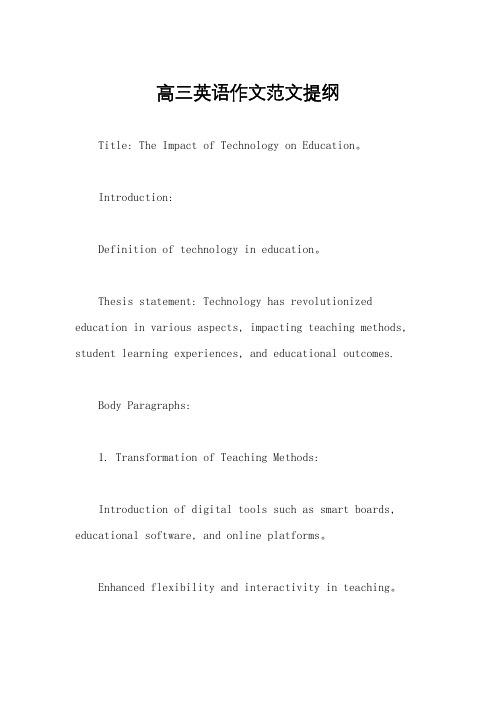
高三英语作文范文提纲Title: The Impact of Technology on Education。
Introduction:Definition of technology in education。
Thesis statement: Technology has revolutionized education in various aspects, impacting teaching methods, student learning experiences, and educational outcomes.Body Paragraphs:1. Transformation of Teaching Methods:Introduction of digital tools such as smart boards, educational software, and online platforms。
Enhanced flexibility and interactivity in teaching。
Examples of flipped classrooms, interactive simulations, and virtual field trips。
2. Personalized Learning Experiences:Customized learning paths based on individual student needs and abilities。
Adaptive learning platforms and algorithms。
Benefits of personalized learning in improving student engagement and academic performance。
3. Access to Resources and Information:Unlimited access to vast resources and information online。
英文提纲作文模板范文
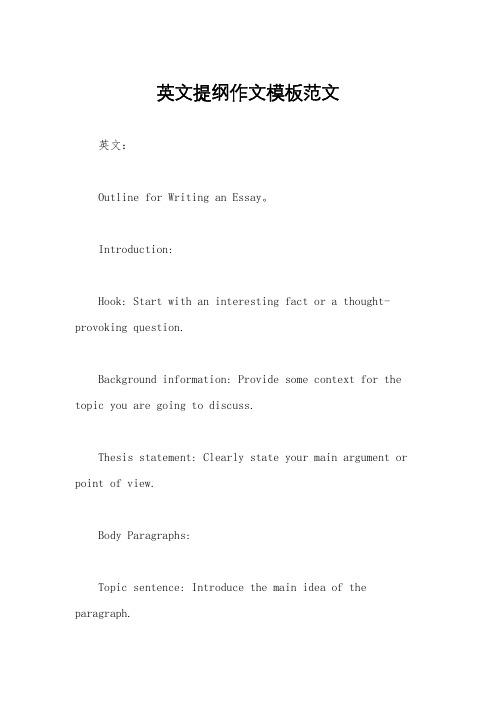
英文提纲作文模板范文英文:Outline for Writing an Essay。
Introduction:Hook: Start with an interesting fact or a thought-provoking question.Background information: Provide some context for the topic you are going to discuss.Thesis statement: Clearly state your main argument or point of view.Body Paragraphs:Topic sentence: Introduce the main idea of the paragraph.Evidence: Provide examples, statistics, or quotes to support your argument.Explanation: Analyze and interpret the evidence to show how it supports your argument.Transition: Use transitional words or phrases to connect your ideas and smoothly move on to the next paragraph.Conclusion:Restate the thesis statement in a new and interesting way.Summarize the main points of the essay.Concluding thoughts: End with a memorable statement or a call to action.中文:提纲作文模板范文。
英文提纲作文模板范文
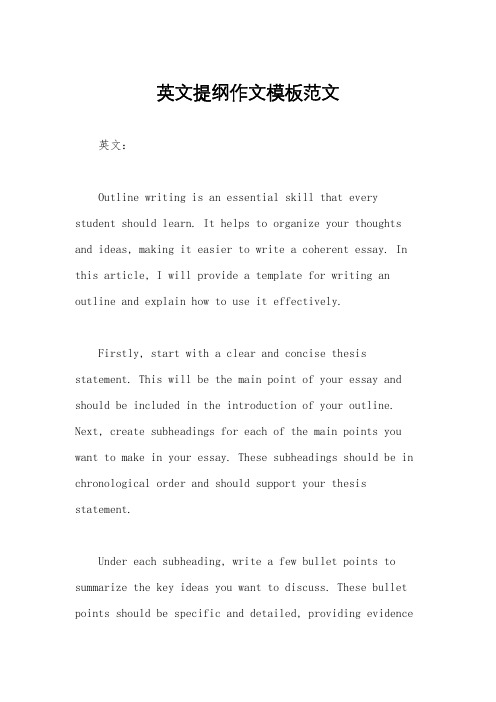
英文提纲作文模板范文英文:Outline writing is an essential skill that every student should learn. It helps to organize your thoughts and ideas, making it easier to write a coherent essay. In this article, I will provide a template for writing an outline and explain how to use it effectively.Firstly, start with a clear and concise thesis statement. This will be the main point of your essay and should be included in the introduction of your outline. Next, create subheadings for each of the main points you want to make in your essay. These subheadings should be in chronological order and should support your thesis statement.Under each subheading, write a few bullet points to summarize the key ideas you want to discuss. These bullet points should be specific and detailed, providing evidenceand examples to support your argument. Remember to include transitional phrases between each subheading to ensure a smooth flow of ideas.Once you have completed your outline, review it to ensure that it is well-structured and coherent. Make any necessary revisions and ensure that your ideas are presented logically and clearly. Finally, use your outline as a guide when writing your essay, referring back to it as you write to ensure that you stay on track and address all of the key points you outlined.中文:提纲写作是每个学生都应该学会的重要技能。
英语论文提纲范文
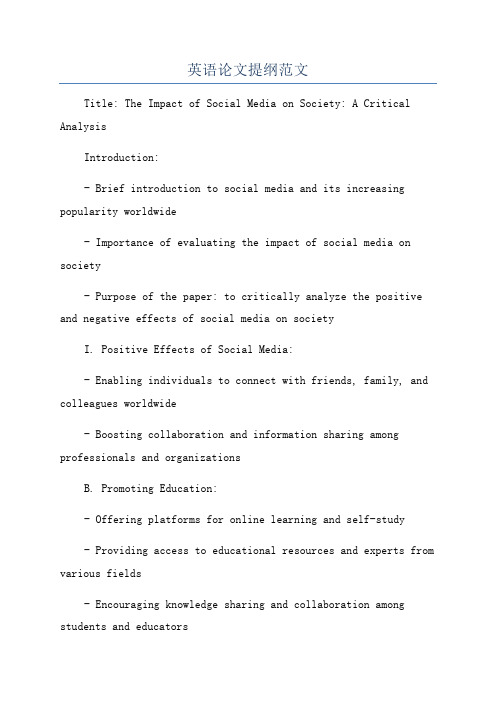
英语论文提纲范文Title: The Impact of Social Media on Society: A Critical AnalysisIntroduction:- Brief introduction to social media and its increasing popularity worldwide- Importance of evaluating the impact of social media on society- Purpose of the paper: to critically analyze the positive and negative effects of social media on societyI. Positive Effects of Social Media:- Enabling individuals to connect with friends, family, and colleagues worldwide- Boosting collaboration and information sharing among professionals and organizationsB. Promoting Education:- Offering platforms for online learning and self-study- Providing access to educational resources and experts from various fields- Encouraging knowledge sharing and collaboration among students and educatorsC. Empowering Activism:- Facilitating the spread of social and political awareness - Enabling individuals and groups to organize and mobilize for social change- Promoting freedom of expression and providing a voice to minority groupsII. Negative Effects of Social Media:A. Addiction and Mental Health Issues:- Excessive usage of social media leading to addiction and dependency- Rise in cyberbullying and online harassment affecting mental health and well-beingB. Invasion of Privacy and Security Concerns:- Vulnerability to hacking, identity theft, and online scams - Unauthorized dissemination of personal information- Manipulation of online behavior through targeted ads and unethical data collectionC. Dissemination of Misinformation:- Proliferation of fake news and misinformation leading to public confusion- Influence on political elections and shaping public opinion- Challenges in distinguishing between credible and non-credible sources of informationIII. Potential Strategies for Mitigating the Negative Effects of Social Media:A. Promoting Digital Literacy:- Educating individuals about the risks and responsibilities of using social media- Encouraging critical thinking and source verification skillsB. Regulation and Legislation:- Developing and enforcing privacy laws to protect user data - Holding social media platforms accountable for their content moderation practicesC. Promoting Well-being and Mental Health:- Encouraging a healthy balance between online and offline activities- Creating support systems for individuals affected by online harassment- Raising awareness about the impact of social media on mental health and providing resources for mental well-being Conclusion:- Recap of the positive and negative effects of social media on society- Importance of evaluating and understanding the impact of social media on individuals and society as a whole。
【推荐】英文论文大纲范例-范文模板 (10页)
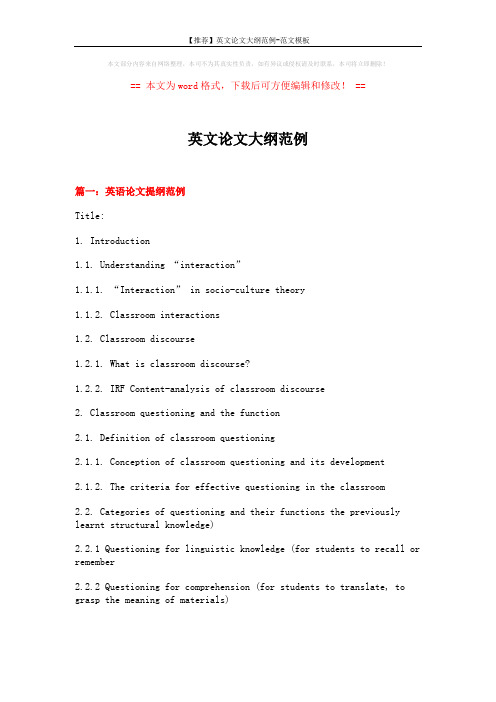
本文部分内容来自网络整理,本司不为其真实性负责,如有异议或侵权请及时联系,本司将立即删除!== 本文为word格式,下载后可方便编辑和修改! ==英文论文大纲范例篇一:英语论文提纲范例Title:1. Introduction1.1. Understanding “interaction”1.1.1. “Interaction” in socio-culture theory1.1.2. Classroom interactions1.2. Classroom discourse1.2.1. What is classroom discourse?1.2.2. IRF Content-analysis of classroom discourse2. Classroom questioning and the function2.1. Definition of classroom questioning2.1.1. Conception of classroom questioning and its development2.1.2. The criteria for effective questioning in the classroom2.2. Categories of questioning and their functions the previously learnt structural knowledge)2.2.1 Questioning for linguistic knowledge (for students to recall or remember2.2.2 Questioning for comprehension (for students to translate, to grasp the meaning of materials)2.2.3 Questioning for application (for students to generalize, or to use learnt materials in new and concrete situations)3. Investigation on classroom questioning3.1 Purpose and object of investigation3.2 Method of investigation4. Conclusion篇二:英语毕业论文的提纲样本本科毕业论文的提纲格式样例A Contextual Study of Black English摘要:对全文进行概括性的总结,涉及到研究背景、研究目的、研究方法、研究发现等;重点放在研究发现上。
英文论文提纲
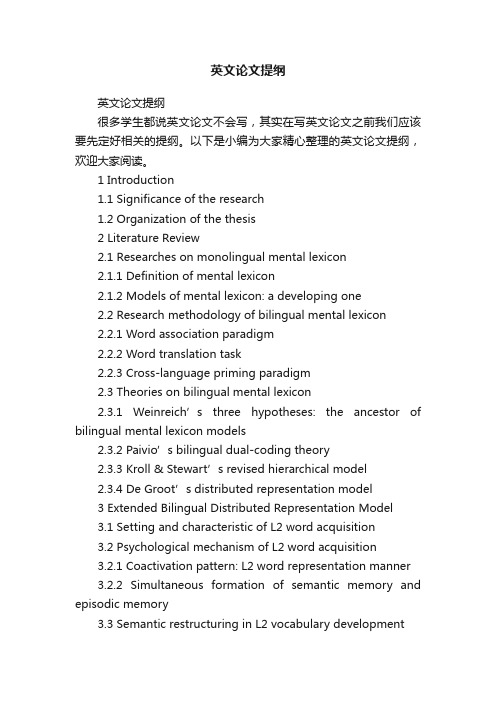
英文论文提纲英文论文提纲很多学生都说英文论文不会写,其实在写英文论文之前我们应该要先定好相关的提纲。
以下是小编为大家精心整理的英文论文提纲,欢迎大家阅读。
1 Introduction1.1 Significance of the research1.2 Organization of the thesis2 Literature Review2.1 Researches on monolingual mental lexicon2.1.1 Definition of mental lexicon2.1.2 Models of mental lexicon: a developing one2.2 Research methodology of bilingual mental lexicon2.2.1 Word association paradigm2.2.2 Word translation task2.2.3 Cross-language priming paradigm2.3 Theories on bilingual mental lexicon2.3.1 Weinreich’s three hypotheses: the ancestor of bilingual mental lexicon models2.3.2 Paivio’s bilingual dual-coding theory2.3.3 Kroll & Stewart’s revised hierarchical model2.3.4 De Groot’s distributed representation model3 Extended Bilingual Distributed Representation Model3.1 Setting and characteristic of L2 word acquisition3.2 Psychological mechanism of L2 word acquisition3.2.1 Coactivation pattern: L2 word representation manner3.2.2 Simultaneous formation of semantic memory and episodic memory3.3 Semantic restructuring in L2 vocabulary development4 Implications for L2 Word Meaning Acquisition4.1 Unbalanced performance on language comprehension and production4.1.1 Receptive vs. productive vocabulary: imbalance on acquisition difficulty4.1.2 Positive effect of episodic memory4.2 Negative semantic transfer4.2.1 Episodic memory: the primary cause of negative semantic transfer4.2.2 Negative effect of episodic memory4.3 Episodic memory and L2 word meaning acquisition4.3.1 Applying episodic memory: when and how4.3.2 Strengthening semantic memory: why and how5 Conclusion。
英文作文提纲 范例
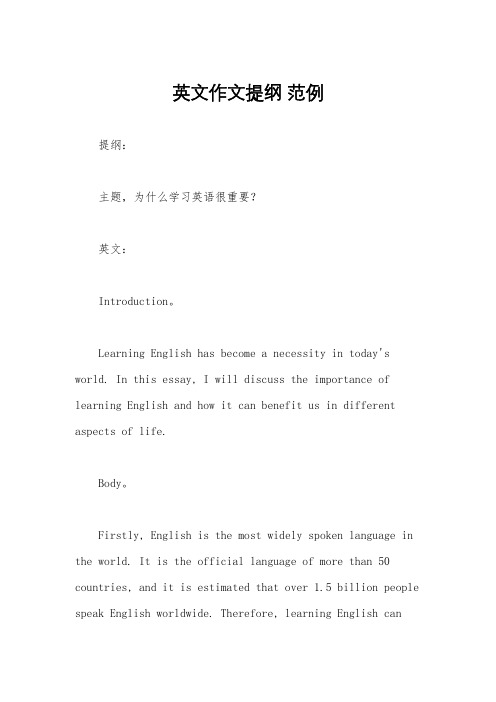
英文作文提纲范例提纲:主题,为什么学习英语很重要?英文:Introduction。
Learning English has become a necessity in today's world. In this essay, I will discuss the importance of learning English and how it can benefit us in different aspects of life.Body。
Firstly, English is the most widely spoken language in the world. It is the official language of more than 50 countries, and it is estimated that over 1.5 billion people speak English worldwide. Therefore, learning English canhelp us communicate with people from different parts of the world, which is essential in today's globalized society.Secondly, English is the language of international business. Most international companies require their employees to have a good command of English. KnowingEnglish can increase our job opportunities and help us advance in our careers.Thirdly, English is the language of science and technology. Most scientific research is published in English, and many of the world's top universities teach in English. Therefore, learning English can help us access valuable information and knowledge in our respective fields.Conclusion。
英语作文提纲怎么写
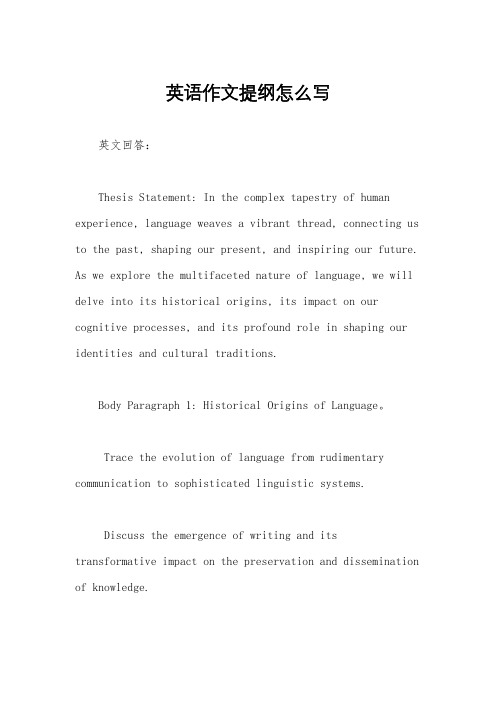
英语作文提纲怎么写英文回答:Thesis Statement: In the complex tapestry of human experience, language weaves a vibrant thread, connecting us to the past, shaping our present, and inspiring our future. As we explore the multifaceted nature of language, we will delve into its historical origins, its impact on our cognitive processes, and its profound role in shaping our identities and cultural traditions.Body Paragraph 1: Historical Origins of Language。
Trace the evolution of language from rudimentary communication to sophisticated linguistic systems.Discuss the emergence of writing and its transformative impact on the preservation and dissemination of knowledge.Examine the linguistic diversity observed across different cultures and time periods.Body Paragraph 2: Language and Cognition。
Analyze the role of language in organizing our thoughts and structuring our experiences.Explore the relationship between language and memory, exploring how words facilitate the encoding and retrieval of information.Discuss how language influences our perception of reality and shapes our understanding of the world.Body Paragraph 3: Language, Identity, and Culture。
英语作文提纲范文
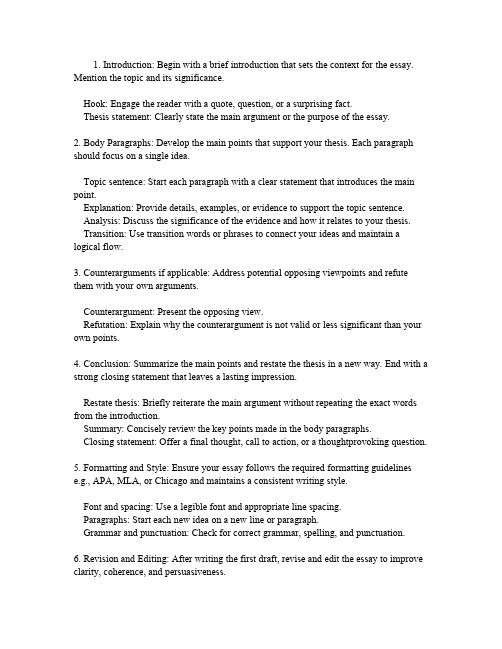
1.Introduction:Begin with a brief introduction that sets the context for the essay. Mention the topic and its significance.Hook:Engage the reader with a quote,question,or a surprising fact.Thesis statement:Clearly state the main argument or the purpose of the essay.2.Body Paragraphs:Develop the main points that support your thesis.Each paragraph should focus on a single idea.Topic sentence:Start each paragraph with a clear statement that introduces the main point.Explanation:Provide details,examples,or evidence to support the topic sentence. Analysis:Discuss the significance of the evidence and how it relates to your thesis. Transition:Use transition words or phrases to connect your ideas and maintain a logical flow.3.Counterarguments if applicable:Address potential opposing viewpoints and refute them with your own arguments.Counterargument:Present the opposing view.Refutation:Explain why the counterargument is not valid or less significant than your own points.4.Conclusion:Summarize the main points and restate the thesis in a new way.End with a strong closing statement that leaves a lasting impression.Restate thesis:Briefly reiterate the main argument without repeating the exact words from the introduction.Summary:Concisely review the key points made in the body paragraphs.Closing statement:Offer a final thought,call to action,or a thoughtprovoking question.5.Formatting and Style:Ensure your essay follows the required formatting guidelinese.g.,APA,MLA,or Chicago and maintains a consistent writing style.Font and spacing:Use a legible font and appropriate line spacing. Paragraphs:Start each new idea on a new line or paragraph.Grammar and punctuation:Check for correct grammar,spelling,and punctuation.6.Revision and Editing:After writing the first draft,revise and edit the essay to improve clarity,coherence,and persuasiveness.Check for consistency in tense and point of view.Ensure that all sentences are clear and concise.Eliminate any redundancy or irrelevant information.7.Citations and References:If your essay includes references to other works,make sure to cite them correctly and include a bibliography or works cited page.Intext citations:Provide the necessary information within the text to guide the reader to the full citation.Bibliography or works cited:List all the sources you have cited in the essay,following the required citation style.8.Peer Review:If possible,have someone else read your essay to provide feedback on clarity,organization,and persuasiveness.Seek feedback on the overall structure and flow of the essay.Ask for suggestions on improving the argument or adding more compelling evidence.9.Final Touches:Make any final adjustments based on feedback and your own review.Adjust the introduction and conclusion to strengthen the essays impact.Ensure that all points are wellsupported and contribute to the thesis.10.Proofreading:Carefully proofread the essay for any remaining errors or inconsistencies.Look for typos,grammatical errors,and punctuation mistakes.Check that all citations and references are accurate and complete.By following this outline,you can create a wellstructured and persuasive English essay that effectively communicates your ideas and arguments.。
英语专业本科论文提纲(中英文对照)
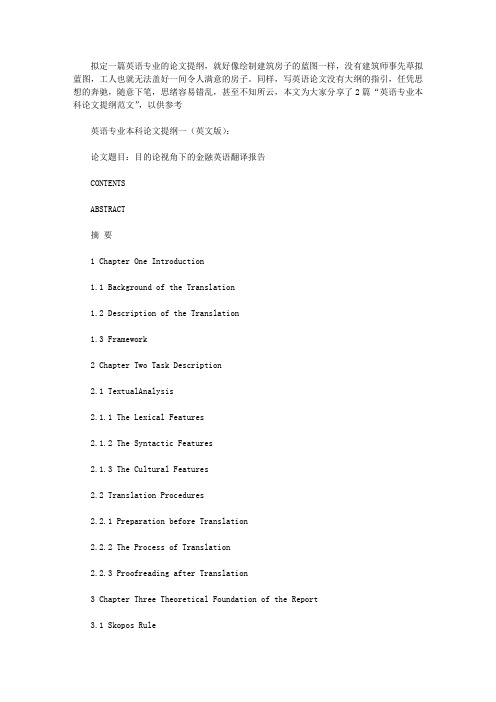
拟定一篇英语专业的论文提纲,就好像绘制建筑房子的蓝图一样,没有建筑师事先草拟蓝图,工人也就无法盖好一间令人满意的房子。
同样,写英语论文没有大纲的指引,任凭思想的奔驰,随意下笔,思绪容易错乱,甚至不知所云,本文为大家分享了2篇“英语专业本科论文提纲范文”,以供参考英语专业本科论文提纲一(英文版):论文题目:目的论视角下的金融英语翻译报告CONTENTSABSTRACT摘要1 Chapter One Introduction1.1 Background of the Translation1.2 Description of the Translation1.3 Framework2 Chapter Two Task Description2.1 TextualAnalysis2.1.1 The Lexical Features2.1.2 The Syntactic Features2.1.3 The Cultural Features2.2 Translation Procedures2.2.1 Preparation before Translation2.2.2 The Process of Translation2.2.3 Proofreading after Translation3 Chapter Three Theoretical Foundation of the Report3.1 Skopos Rule3.2 The Principle of Coherence3.3 The Principle of Fidelity4 Chapter Four CaseAnalysis4.1 Literal Translation Strategy4.1.1 The Reason of Using Literal Translation Strategy4.1.2 TheApplication of Literal Translation Strategy4.2 Contextual Translation Strategy4.2.1 The Reason of Using Contextual Translation Strategy 4.2.2 TheApplication of Contextual Translation Strategy4.3 Domesticating Translation Strategy4.3.1 The Reason of Using Domestication Translation Strategy4.3.2 TheApplication of Domesticating Translation Strategy5 Chapter Five Conclusion5.1 Summary5.2 Limitations and SuggestionsBIBLIOGRAPHYACKNOWLEDGEMENTSPUBLISHED PAPER英语专业本科论文提纲二(中文版):论文题目:《绝望的主妇》口译配音实证探讨目录摘要第一章绪论1.1研究动机1.2研究目的1.3研究范围1.4研究方法1.5论文结构第二章文献分析2.1关联理论的研究2.2口语背景的语言研究观2.3语意对等的口译观2.4口语口译研究第三章《绝望的主妇》语意关联成分探讨3.1情境喜剧《绝望的主妇》简介3.2人物特质和关联方式3.3言语关联语言分析3.4口译中的关联手法第四章《绝望的主妇》口译配音实证探讨4.1 口译合作原则4.2口译中的礼貌原则4.3口译言语行为准则研究4.3.1口语用语习惯4.3.2语法的正确表达4.3.3语意的精确表现4.3.4准确口译原文句子的意境第五章结论与建议5.1结论5.2研究应用5.3研究限制5.4未来研究方向参考文献致谢。
英语专业毕业论文提纲范文

英语专业毕业论文提纲范文精选英语专业毕业论文提纲怎么写?下面是为大家的英语专业毕业论文提纲精选,欢送参考~Why should we write the thesis?To write a thesis before graduation is a must for every university graduate.By writing a thesis, we may get some experience and some basic methods for further theoretical study and research and the ability to solve problems.It is the reflection of a student s study in college.Whether a student has such an ability to write a thesis or to solve problems in his/her field is one basis for a unit to aept him/her or not.How long should we prepare for writing a thesis?One year or soWhat do we need when we write a thesis?Firstly, for English major, most important of all, it is English knowledge and ability that based on your language skills, especially writing skill and grammar knowledge.Secondly, the way of writing is also important.A good title, some good ideas to support thesis statement, right language and standard format are what we need.The language style is something that we should pay much attention to, for example:Wording: we prefer big word to small one;Sentence: Long sentences are quite expectable.How do we write a thesis? How many steps should we follow?Generally speaking, when we write a thesis, we follow1steps:Choose a subject: that is, what you are going to write about. For English major, we may apply:Choose a title/Title a paper;Collect materials for reference in writing;Analyze the collected materials;Sort out the data and arguments;List references;Make up an outline;drafts;Proofread;The last version.What subjects may we choose to write?English and American LiteratureThe Practice and Theory of TranslationEnglish LanguageEnglish LinguisticsEnglish GrammarEnglish PhoicsEnglish LexicologyEnglish RhetoricLanguage and CultureELT MethodologyTeaching English in Middle School English Teaching Research and Survey The History of (All mentioned above)。
提纲作文模板英文

提纲作文模板英文英文:Introduction:As a student, I have been asked to write many essays and reports. In this article, I will share with you a useful outline for writing an essay.Body:1. Introduction: In the introduction, you should introduce the topic of your essay and provide some background information. You should also state your thesis statement, which is the main argument of your essay.2. Body Paragraphs: The body of your essay should consist of several paragraphs, each discussing a different aspect of your topic. Each paragraph should begin with a topic sentence that introduces the main idea of theparagraph. You should then provide evidence and examples to support your argument.3. Counterarguments: In your essay, you should also address any potential counterarguments to your thesis statement. This shows that you have considered different perspectives and strengthens your argument.4. Conclusion: In the conclusion, you should summarize your main points and restate your thesis statement. You can also provide some final thoughts or recommendations.中文:介绍:作为一名学生,我写过很多论文和报告。
英语论文提纲格式范文

英语论文提纲格式范文英语论文提纲格式范文一.课题研究目的意义随着经济全球化趋势的进一步增强,英语日益成为我国对外开放和与各国进行经济文化等方面交流的重要工具,因此如何改进英语教学已成为人们街谈巷议的话题和举目关注的焦点。
我校经过三年多的实践和研究,已初步确立了小学英语活动体系的目标和模式,实践证明小学英语活动体系是必要的,可行的,普遍适应小学生身心发展规律。
近年来我国基础外语教育有了很大的发展,然而,在大力发展基础英语教育的同时。
很多教师却不同程度地忽略了儿童心理认知的特点。
综观我们的外语课堂教学,教师的教学理念与社会的要求还有较大的差距。
在传统的教学方法的影响下,教师仍占去课堂大部分时间,导致为学生成为语言知识的消极接受者。
因而从更高的层面上来反思小学英语教学,真正的把小学英语活动体系应用到日常英语教学与英语活动中去就显得尤为重要。
为了改变现状,更好地贯彻教育部关于《英语课程标准》的精神,培养学生交际运用语言的能力,实现知识、技能向能力的转化,培养学生在英语活动中生动活泼`积极主动地发展,我们提出了《小学英语活动的实效性研究》的课题研究。
二、理论依据和研究目标理论依据:活动型教学方式符合外语教学理论中的“情感过滤”假设。
有利于调节儿童的情感因素。
“情感过滤说”(the Affective Filter Hypothesis)是Dulay 和Burt于1977年提出的,旨在解释情感因素如何影响外语学习的过程。
情感过滤说认为,有了大量可理解语言信息的输入并不等于学生就能学好目的语,因为外语教学的进程还受到情感因素的影响。
语言输入必须通过情感过滤才有可能变成语言的吸收,也就是说,情感因素起着促进或阻碍语言获得的作用。
对教师来说,重要的是如何总结经验,寻找办法来激发学生的学习兴趣,强化情感因素对他们语言习得的正面影响。
符合儿童心理和生理特点的活动型教学法,可以寓教于乐,减轻心理压力,降低情感过滤,增加儿童愉快的情感体验,形成良好的心理倾向,激活儿童学习的兴趣和动机。
- 1、下载文档前请自行甄别文档内容的完整性,平台不提供额外的编辑、内容补充、找答案等附加服务。
- 2、"仅部分预览"的文档,不可在线预览部分如存在完整性等问题,可反馈申请退款(可完整预览的文档不适用该条件!)。
- 3、如文档侵犯您的权益,请联系客服反馈,我们会尽快为您处理(人工客服工作时间:9:00-18:30)。
Idiom Translation under the Chineseand English CulturesClass XXX Number XXX Name XXXAbstract:Nida, a famous translator, says, "For truly successful translation, it is much more important to familiarize two cultures than master two languages, because words are assigned meanings in its particular cultures."(Background information) This is to say, translation is closely related with not only languages but also cultures. Studies of the cultural distinction in idiom translation are still relatively weak in the field of translation in China. Exclusive research on the translation of Chinese and English idioms is still incomplete.In the last twenty years, idiom translation has mostly emphasized the level of inter-lingual communication, but cultural differences were rarely involved in it.(Identify problem)This thesis analyses the cultural differences in Chinese and English idioms, then studies English-Chinese\Chinese-English idiom translation methods(Research subject)from the angle of culture(Method)and points out some warnings concerning idiom translation: pay attention to context and choose the right version in line with the style and meaning of the original passage(Results); culture is a whole way of life, when new culture emerges, new idioms also appear, therefore idiom translation should develop with the time.(Conclusion)Key Words: idioms; culture; translation论英汉文化背景下的习语翻译摘要:著名翻译学家奈达指出:“对于真正成功的翻译而言,熟悉两种文化甚至比掌握两种语言更为重要,因为词语只有在其作用的文化背景下才有意义。
”也就是说,翻译不仅与语言有关也和文化有关。
习语翻译中对文化差异的研究在中国的翻译领域中仍然较弱,专门对中英习语翻译的研究还不很完善。
近20年来,习语翻译大多强调语际的交流,而很少涉及文化差异。
本文通过分析中英习语的文化差异,进而从文化角度研究中英习语翻译方法,并指出中英习语翻译要注意的问题:联系上下文,选择与原文风格,意思相符的翻译;文化是一种生活方式,文化在变化,出现新的习语,习语翻译要与时俱进。
关键词:习语;文化;翻译1. IntroductionIdioms universally exist in every language. An Idiom is a word or an expression that cannot be literally translated from the source language into the target language because its idiomatic meaning cannot be understood by literally defining its component parts.(Background) In a broad sense, idioms contain set phrases, proverbs, colloquialisms, slangs, maxims, allusions, etc. (YinLi, 2007:9) In Chinese, they also include enigmatic folk similes. Newmark, a British translation theorist, in his work A Textbook of Translation, said, "I define as culture the way of life and his manifestation that are peculiar to a community that uses a peculiar language as its means of expression. "(Previous research)English Idioms derives from English cultures and daily life. In real context, idioms explain themselves: nine times out of ten they carry their own explanations. If we are unaware of these, we will find ourselves in a state of confusion since we will assign literal meaning to them. The Chinese Idioms, especially the four-character idioms, have their own unique origins which are closely correlative to the Chinese history and cultures.In view of the difficulties in understanding idioms, we should pay due attention and efforts to understand their cultures and customs. This thesis is designed to dig into the cultural differences between Chinese and English and then elaborates on the translation theories applied to idioms. (Subject + Method)2. A Comparison Between English and Chinese Idioms2.1 The Cultural Differences Between English and Chinese Idioms2.1.1 Geographical ConditionsThe formation of culture is closely related with natural geographical conditions. A specific geographical environment produces a specific culture, which also leads to a particular expression.Great Britain covers islands including the Northern one-sixth of the island ofIreland between the North Atlantic Ocean and the North Sea, northwest of France. It has a moist climate with much rainfall. Rivers and lakes are numerous. No wonder that fishery is thriving and most important in Britain. Accordingly, idioms concerning fish and navigation constitute a great part in English idioms. (LiYuping, 2008:20)(Theory/Results of previous research)For example, "like a fish out of water". If you feel like fish out of water, you feel awkward and uncomfortable because you are in an unusual and unfamiliar situation.Fish in the air 缘木求鱼An odd fish 怪人Miss the boat 错过机会Trim the sails to the wind 顺势前进A small leak will sink a great ship 小洞不补要沉大船(Examples)On the other hand, China is located in the Asian Continent and reputed as an agricultural country with a large population of peasants. It is not surprising to find many idioms relevant to farming, such as "骨瘦如柴,对牛弹琴, 众人拾柴火焰高,竹篮打水一场空......". Chinese people also have a mysterious and awe feeling for sea, so they have idioms like "海角天涯,海枯石烂,海阔天空,海底捞针,海市蜃楼......". (Analysis)2.1.2 History……………………………………………………………………………….……………………………………………………………………………….……………………………………………………………………………….2.2 The Similarities Between English and Chinese Idioms……………………………………………………………………………….……………………………………………………………………………….……………………………………………………………………………….2.2.1 Colours……………………………………………………………………………….……………………………………………………………………………….……………………………………………………………………………….……………………………………………………………………………….2.2.2 Numbers……………………………………………………………………………….……………………………………………………………………………….……………………………………………………………………………….3. Methods of Idiom TranslationTranslation is far more than a science. It is also a skill, and at the ultimate analysis, fully satisfactory translation is always an art. (Nida, 1982:49) Translation is considered as the cultural bridge and media between two languages. As there are wide differences in vocabulary and syntax between English and Chinese, translation is no easy job. Therefore, in order to keep the flavor of the original as well as cater for both the Chinese and English languages, translation skills should be reasonably employed in the process of translating, such as the following translating methods:3.1 Literal Translation……………………………………………………………………………….……………………………………………………………………………….……………………………………………………………………………….3.2 Free Translation……………………………………………………………………………….……………………………………………………………………………….……………………………………………………………………………….3.3 Translation with Notes……………………………………………………………………………….……………………………………………………………………………….……………………………………………………………………………….3.4 Replacement with Similar Idioms……………………………………………………………………………….……………………………………………………………………………….……………………………………………………………………………….3.5 The Translation of Corresponding Idioms with the Same Meaning……………………………………………………………………………….……………………………………………………………………………….……………………………………………………………………………….3.6 A Combination of Literal and Free Translation……………………………………………………………………………….……………………………………………………………………………….……………………………………………………………………………….4. Some Warnings Concerning Idiom Translation……………………………………………………………………………….……………………………………………………………………………….………………………………………………………………………………. 5. ConclusionOne of the major characteristics identifying us as human is our ability to use language. Language plays a very important role in people’s daily life; it enables people communicate with each other and understand others' feelings. Language has close relations with culture. It is impossible to separate language from culture. As the essence of language, idioms also have close relations with culture. The contents of them range from society, history, psychology to customs and other various social phenomena. So, in the process of translation, translators should pay more attention to the cultural factors, in doing this, he can dig up the implicit meanings. (Conclusion of research) Only the cultural factors are concerned, translators can have a satisfactory translation. Besides, people should get acquaintances with the cultural background when using idioms to avoid embarrassment in communication. (Suggestions)References[*] 作者. 书名(英语的斜体). (出版地:)出版社,年份:参考内容页码[*] 作者. 文章名(英语的斜体). 刊物名称. (出版地:)出版社,年份[1] Li Mei. Mother tongue and translation. Shanhai: Shanhai Foreign Language Education Press,2008[2] Li Qingming. A Comparison of the Cultures between the Chinese and English Language. Xi'an: Northwest University of technology Press, 2007[3] Nida Eugene. The theory and Practice of Translation. Leiden: E. J. Brill, 1982[4] Nida Eugene. Language, Culture, and Translating. Shanhai: Shanhai Foreign Language Education Press, 1993[5] Susan Bassnett, Andre Lefevere. Translation, History, Culture.Shanghai: Shanhai Foreign Language Education Press, 1987[6] Luo Shiping. A Research on English Idioms. Shanhai: Shanhai Foreign Language EducationPress, 2006[7] Li Yuping. English Idioms and their Cultural Origin. Tianjin: Nankai University Press, 2008[8] Yin Li. English-Chinese Idioms and Folk Culture. Beijing: Bejing university Press, 2007[9] Zhang Yajun. A Kaleidoscope of Chinese Culture. Beijing: Sinolingua, 2008\[10] 李云(Li Yun).《新编大学翻译教程》. 北京:世界知识出版社, 2007[11] 马爱英(Ma Aiying).《中英文化翻译》. 北京:科学出版社, 2006[12] 孙致礼(Sun Zhili).《新编英汉翻译教程》. 上海:上海外语教学出版社, 2008[13] 王宗炎(Wang Zongyan).《英汉语文问题面面观》. 北京:北京高等教育出版社, 2006。
